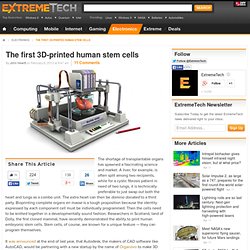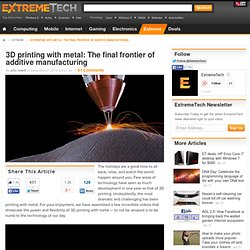

An Inside Look at Ping Fu's GeoMagic & 3D Printing. Opinions: 3D Printing: A New Dimension for Manufacturing. By Theodore F. di StefanoE-Commerce Times 07/20/12 11:32 AM PT 3D printing technology is still in its infancy, but it will grow in the coming years.

In this business environment of the future, executives must focus on engineering, computer technology, product design, marketing and research and development. They must also focus on hiring employees who are highly skilled in engineering and the sciences, especially computer science. ManageEngine OpManager, a powerful NMS for monitoring your network, physical & virtual (VMware/ HyperV) servers, apps & other IT devices. Deploy and start monitoring in less than an hour. 3D printing to be a $20 billion global industry by 2019. 3D modeling. Pushing the Boundaries : 3-D Printing « Indian Young Scientist Network. One of the 3-D printers at work in the Mediated Matter group at the MIT Media Lab.

Imagine being able to “print” an entire house. Or a four-course dinner. Or a complete mechanical device such as a cuckoo clock, fully assembled and ready to run. Or a printer capable of printing … yet another printer? These are no longer sci-fi flights of fancy. One of the first practical 3-D printers, and the first to be called by that name, was patented in 1993 by MIT professors Michael Cima, now the Sumitomo Electric Industries Professor of Engineering, and Emanuel Sachs, now the Fred Fort Flowers (1941) and Daniel Fort Flowers (1941) Professor of Mechanical Engineering.
The initial motivation was to produce models for visualization — for architects and others — and help streamline the development of new products, such as medical devices. 3D printing: The printed world. Latest Technology News. Stanford creates touch-sensitive, conductive, infinitely-self-healing synthetic skin. Stanford University material scientists have devised the first synthetic, plastic skin that is conductive, sensitive to touch, and capable of repeatedly self-healing at room temperature.

The most immediate applications are in the realm of smart, self-healing prosthetic limbs that are covered in this synthetic skin — but in the long term, the plastic might be used to make self-healing electronic devices, or you might even elect to replace your fingertips (or other piece of skin) with the synthetic, bionic equivalent.
There are two important innovations here: a synthetic material that can repeatedly self-heal, and the fact that it’s electrically conductive — meaning it can detect changes in pressure and temperature (i.e. it’s sensitive, like real skin). We’ll tackle the self-healing bit first. The Stanford team, led by Zhenan Bao, started with plastic polymer that’s held together with hydrogen bonds. To make the plastic conductive, the team simply mixed in some microparticles of nickel. First inkjet-printed graphene computer circuit is transparent, flexible. You can add another crazy characteristic to graphene’s ever-expanding list of “wonder material” properties: It can now be used to create flexible, transparent thin-film transistors… using an inkjet printer.

The discovery comes from researchers at the University of Cambridge, UK, who were trying to ameliorate the lackluster performance of existing inkjet-printed electronics. As we covered last month, it’s possible to print standard CMOS transistors using different ferroelectric polymer inks, but the resultant circuit is so slow that it can’t actually function as a computer. If graphene could replace or augment the interconnects or transistors, these circuits would be a lot faster — and that’s what these Cambridge engineers have done. The actual meat of the discovery is that graphene has been successfully chipped off a block of graphite using a chemical solvent. The first 3D-printed human stem cells. The shortage of transplantable organs has spawned a fascinating science and market.

A liver, for example, is often split among two recipients, while for a cystic fibrosis patient in need of two lungs, it is technically preferable to just swap out both the heart and lungs as a combo unit. The extra heart can then be domino donated to a third party. Bioprinting complete organs en masse is a tough proposition because the identity expressed by each component cell must be individually programmed. Then the cells need to be knitted together in a developmentally sound fashion. Researchers in Scotland, land of Dolly, the first cloned mammal, have recently demonstrated the ability to print human embryonic stem cells. 3D printing with metal: The final frontier of additive manufacturing. The holidays are a great time to sit back, relax, and watch the world happen around you.

Few areas of technology have seen as much development in one year as that of 3D printing. Undoubtedly, the most dramatic and challenging has been printing with metal. For your enjoyment, we have assembled a few incredible videos that showcase the power and flexibility of 3D printing with metal — to not be amazed is to be numb to the technology of our day. The first attempts to print with metal can be traced back to the 1880s when the first welders used carbon electrode arcs to fuse two pieces of metal. It was later found that if a third sacrificial stick of material was used a metal bead could be laid down. The real breakthrough that has enabled 3D printing for the masses has been the laser.
NASA recently used a technique called selective metal melting (SLM) with great success to build rocket motor components out of steel. What is 3D printing? 3D printing is a method of manufacturing everything from shoes to jewelery, to guns and aerospace parts, using a computer-controlled printer.

The fundamental rule of 3D printing is that it’s an additive manufacturing technique, unlike machining, turning, milling, and sawing which are subtractive. While there are different kinds of 3D printing, all 3D objects are generally built out of layers. A 3D printer starts with the bottom layer, waits for it to dry or solidify, and then works its way up. This layering process differs depending on the printer and the material it works with — metal, plaster, polymer, resin — but it also depends on whether it’s an industrial or commercial 3D printer. Industrial vs. commercial. 3D Printing: What You Need to Know. They're not your granddad's daisy wheel printer, or your mom's dot matrix.

In fact, they bear little resemblance to today's document or photo printers, which can only print in boring old two dimension. As their name suggests, 3D printers can build objects from scratch out of a variety of materials. They're going mainstream, showing up at retailers such as Staples, Best Buy, and Home Depot, and you can buy numerous 3D printers and their supplies on Amazon.com and through other online outlets.
What is 3D printing? A beginner’s guide to the desktop factory. Makers: The New Industrial Revolution. Technology - 3D Printing. 3d Print. 3D printing. 3D Printing. 3D printing and milling. Make: 3D Printing. Other (3D printing) 3D Printing. You are in: Future Technologies : 3D Printing 3D Printing Imagine a future in which a device connected to a computer can print a solid object.

A future in which we can have tangible goods as well as intangible services delivered to our desktops or highstreet shops over the Internet. And a future in which the everyday "atomization" of virtual objects into hard reality has turned the mass pre-production and stock-holding of a wide range of goods and spare parts into no more than an historical legacy. Such a future may sound like it is being plucked from the worlds of Star Trek. The following provides an overview of 3D printing technologies and their present and likely future application. Current Technologies.